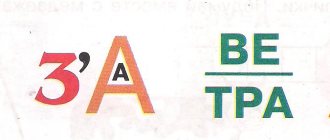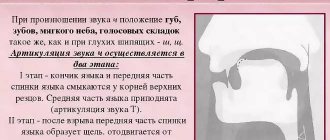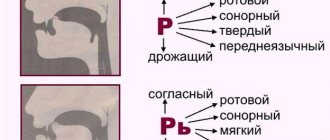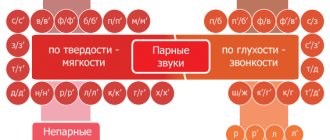It is worth practicing with children for any speech problems!
Speech disorders are said to occur if a child's speech skills do not correspond to his age. Many disadvantages are difficult to overcome on your own. Pedagogical science - speech therapy - helps to cope with them.
It’s worth remembering: no matter what childhood speech disorders are, they definitely need to be dealt with and not left to chance. Mild speech problems may disappear completely. With reasonable effort and practice, this will happen faster. Moderate and severe violations are subject to partial correction.
Hopeless cases occur only with complex defects of the articulatory apparatus, psyche or brain structures, but there are options here too.
The child will have to adapt to life in society, and our task is to help him do this as painlessly as possible. Intelligible, clear speech and the ability to formulate thoughts influence socialization. Although we try to fight it, children with speech disorders are often teased, we must try to avoid this. It is important that the child is understood by his peers and others, this affects his self-esteem and desire to adapt to society.
Where do speech disorders come from?
Speech disorders are problems with verbal communication, speech motor skills, and related areas. They are very diverse: some are associated with the inability to speak, others with speech incontinence. They arise due to physiological, neurological or mental problems, due to pedagogical neglect. Any speech disorder is not a reason to stigmatize a child, much less shame him.
Difficulties with speech can be organic, that is, caused by damage to the speech organs. They are like this:
- Hereditary, when the problem was passed on from parents. It happens that one of the parents at one time began to speak later, has peculiarities in the bite or setting of the teeth, and this is passed on to the children.
- Congenital (intrauterine) pathologies. Caused by the difficult course of pregnancy or taking medications, hypoxia, infectious disease of the pregnant woman, blood incompatibility, prematurity or postmaturity, maternal stress or intoxication.
- Perinatal (caused by complications during childbirth). Priority attention should be given to children who suffered asphyxia or head trauma due to a narrow birth canal, were born weighing less than 1.5 kg and were resuscitated.
- Postnatal (caused by diseases in the first months or years of life). Speech disturbances can cause infections (meningitis, otitis media), head injuries and palatal injuries.
- Social and everyday, when the child lacks emotional and verbal communication with loved ones. These are not necessarily families with drinking parents - it happens that quite successful mothers and fathers simply do not have enough time for their children.
Also, speech disorders can be of an endocrine nature (due to the characteristics of the child’s psychomotor development), functional (defects or characteristics of the speech organs), psychosomatic or caused by the environment.
Speech disorders: classification and types
Speaking about the general classification of existing types of speech disorders, we can highlight the following:
1- Dysarthria:
These are pronunciation disorders caused by damage to the muscles of the speech apparatus.
2- Dyslalia:
Dyslalia is a sound pronunciation disorder characterized by the absence, substitution, confusion, or distortion of phonemes and sounds in spoken speech. There are several types of dyslalia:
- Physiological dyslalia: children often pronounce sounds incorrectly - this is due to the insufficient development of speech organs in childhood. This is absolutely normal and should not alarm parents - unless the problem does not go away on its own over time.
- Audiogenic dyslalia: As the name suggests, this disorder involves a child's hearing impairment that prevents them from correctly recognizing, imitating, and producing sounds. It is logical that if a person has difficulty hearing, he will also have difficulty speaking.
- Functional dyslalia: long-term physiological dyslalia, which has already been preserved when the speech apparatus has been formed, can develop into functional dyslalia. With this type of dyslalia, the structure of the organs is not disturbed, but the child mixes, distorts or replaces sounds.
- Organic or mechanical dyslalia: This type of dyslalia is also called dysglosia. They are associated with structural defects of the speech organs. Let's take a closer look.
3- Dysglossia
Dysglosia (not to be confused with diglossia or a variant of bilingualism) is a speech disorder, as we mentioned above, associated with defects (clefts) of the organs involved in speech. The following subspecies are distinguished:
- Lip dysglosia: associated with changes in the shape of the lips, cleft lips. The most well-known pathologies of this type are cleft lip and cleft palate.
- Dysglossia of the jaw: caused by irregularities in the shape, clefts of the upper, lower or both jaws.
- Dental dysglosia: speech disorder due to gaps between teeth or misalignment of teeth.
- Tongue dysglossia: Caused by clefts and other defects of the tongue. Pathologies that may be the causes of these disorders are ankyloglossia (short frenulum of the tongue), macroglossia (abnormally large tongue), and unilateral or bilateral paralysis.
- Nasal dysglossia : associated with pathologies that do not allow air to enter the lungs correctly.
- Palatal dysglossia: caused by cleft palates.
4- Dysphemia
Dysphemias are speech disorders characterized by impaired articulation with repeated interruptions and repetitions caused by poor ideomotor brain coordination. An example of dysphemia is stuttering.
5- Aphasia
This type of speech disorder can manifest itself at any age, since it is associated with local damage to the parts of the brain involved in speech and represents the absence or impairment of already formed speech.
- Broca's aphasia: Broca's aphasia or efferent motor aphasia is caused by damage to the motor speech center or Broca's center and adjacent areas. Characterized by great difficulties with articulation and telegraphic speech (very short phrases). Speech expression suffers the most (hence why it is also called expressive aphasia), while speech understanding is preserved or suffers less.
- Wernicke's aphasia or sensory aphasia: a speech disorder caused by damage to the left temporal lobe, adjacent to the auditory cortex. It is characterized by fluent but uninformative (paragrammatic) speech, impaired phonemic hearing, and problems distinguishing the sound composition of words. Sufferers of this disorder also have difficulty understanding speech.
- Conduction or conduction aphasia: This type of motor aphasia is caused by damage to the arcuate fasciculus and/or other connections of the temporal and frontal lobes. The disorder is characterized by an impairment in the ability to repeat words and sentences, while maintaining understanding and fairly fluent spontaneous speech. Conductive aphasia often causes problems with reading, writing, and remembering names.
- Transcortical sensory aphasia: This type of language disorder is caused by damage to the connections between the parietal and temporal lobes and is associated with impaired comprehension of single words, although repetition ability is relatively intact. Transcortical motor aphasia: This language disorder is caused by subcortical lesions in areas below the motor cortex and is associated with impairments in spontaneous speech, but memory for names is not affected. Anomic aphasia: associated with lesions in various areas of the temporal and parietal lobes and is characterized by disturbances in the pronunciation of individual words. Global or total aphasia: complete loss of the ability to speak and understand speech. All language functions are impaired.
6- Dyslexia
Dyslexia is a learning disorder in reading and writing that is associated with a neurodevelopmental disorder. Currently, there are professional tools for neuropsychological testing of dyslexia, for the correction of dyslexia at school, as well as games for cognitive training of children with dyslexia.
7- Specific speech disorder
Specific language or language development disorder is a delay in the learning and use of language or the inability to use it in the absence of brain damage, normal mental development, adequate sensory development and the absence of psychopathology. Often children with a specific language disorder also show signs of dyslalia and the other disorders mentioned above.
8- ADHD or Attention Deficit Hyperactivity Disorder
ADHD is associated with language impairment and also causes learning and communication problems. Research shows that children with ADHD experience difficulties with syntax and phonological organization of speech. They also have problems with semantic organization and auditory memory. Currently, tools have been developed for neuropsychological testing of ADHD, neuroeducational programs to address learning difficulties in school, and games for cognitive stimulation of children with ADHD.
9- Dyscalculia
Despite the fact that this disorder does not affect speech (as much as others), in this case the understanding of another language - mathematical - suffers. Dyscalculia affects the ability to work with numbers and understand mathematical terms. People suffering from dyscalculia do not understand the logic of the mathematical process. Currently, there are professional instruments for neuropsychological testing of dyscalculia and games for cognitive stimulation of children with dyscalculia.
What should parents be wary of in their child’s speech?
Symptoms of speech disorders can be different: a poor vocabulary (the baby does not remember words well, confuses endings, speaks little, uses generalizations), poor understanding of words or phrases, and inability to reproduce certain sounds. The most famous defect is stuttering, which disrupts the rhythm and fluency of speech.
According to experts, the problem can be identified very early. You need to communicate with your baby from the first moments of his life, even when he is not able to consciously react. If a child does not show similar communicative activity as other children of his age, you should pay attention. But this in itself is not a diagnosis; you don’t need to beat yourself up right away.
The features listed in the table may indicate problems with speech in children.
| Month of life (by the end of the month) | What the baby can't do |
| 1 | Doesn't cry when hungry or uncomfortable |
| 4 | Doesn't smile back when people talk to him |
| 5 | Does not produce sounds or sound combinations. Does not look for things that an adult is pointing at |
| 7 | Does not know how to attract the attention of adults using sounds |
| 9 | There are still no words consisting of two repeated syllables (ma-ma, ba-ba, na-na) |
| 10 | The child does not speak 8 syllables. Doesn’t shake his head in denial, doesn’t make a “bye-bye” gesture with his pen |
| 12 | Doesn’t say a word, doesn’t react to simple requests (“give me the ball”) |
| 15 | Can't even say "mom" or "dad" |
| 19 | Doesn't speak meaningful words. Doesn't point at body parts the parent is talking about |
| 29 | Doesn’t understand the difference between “big” and “small” |
The last indicator - the end of the 29th month - is close to the time when it is time for the child to go to kindergarten. Violations, if any, are already noticeable by this point. If these problems occur, you should visit a consultation:
- otolaryngologist (perhaps the baby speaks poorly because he cannot hear);
- neurologist (check for organic damage to the central nervous system, speech centers of the cerebral cortex);
- child psychologist, psychiatrist, defectologist (find out the state of the child’s non-verbal intelligence);
- speech therapist (will conduct a final diagnosis).
Symptoms of speech disorders
Depending on the type of speech disorder and the area affected, there are various symptoms that indicate a possible speech disorder. Speaking about the classification of common symptoms of speech disorders, the following types of symptoms can be distinguished:
- Symptoms of expressive language disorder: In this disorder, the vocabulary is very limited and the person has difficulty remembering and speaking long phrases.
- Symptoms of expressive-receptive speech disorder: in addition to the symptoms observed in the previous case, there are also problems associated with the perception, understanding of speech, words or phrases.
- Symptoms of a phonological disorder: characterized by an inability to use individual sounds in conversation, and there are errors in the pronunciation, production and/or use of sounds.
In addition, perhaps one of the most noticeable disorders is stuttering - a violation of the fluency, rhythm and organization of speech.
Despite the fact that speech is a complex process, and there are many different speech pathologies , certain signs can be identified that generally indicate the possible development of a speech disorder. Speaking about speech disorders in children, the following signs can be noted:
- Expressive speech disorder: this problem may be indicated by the child’s poor vocabulary compared to children of his age, or underdeveloped speech. It is difficult for a child to remember new words, he confuses the tense forms of verbs, uses generalizing words in conversation (things, this, etc.) instead of specific names, speaks little, pronounces meaningless phrases, although he is able to pronounce words correctly, uses certain sentence structures or constantly repeats the same phrases when speaking.
- Receptive language disorder: With this speech disorder, the child often has no interest in talking in his presence and has difficulty following directions or understanding what is said, asked, or written.
Types of speech disorders (classification from a medical point of view)
Speech problems in preschool children can be classified according to clinical-pedagogical and psychological-pedagogical indicators. The two classifications should be considered together: together they help to understand the cause of the violation and determine ways to eliminate it.
The clinical and pedagogical classification is closer to the medical one, and we’ll talk about it now. She divides speech deviations into oral and written. The first can be phonational or systemic.
With phonation, the source of the problem can be improper voice formation, sound pronunciation, tempo, and intonation. That is, the child understands speech directed to him 100%, but cannot reproduce it. The following phonation disorders are classified (in alphabetical order):
- Bradylalia is a slow rate of speech.
- Dysarthria is a disorder due to insufficient innervation of the articulatory apparatus.
- Dysglosia - difficulties with pronunciation due to palatal, jaw, and other clefts.
- Dyslalia is a deviation with full hearing and intact speech apparatus.
- Dysphonia is a complete or fragmented disorder of phonation due to an abnormality of the vocal apparatus.
- Stuttering is a disruption in tempo due to spasms of the jaw muscles.
- Rhinolalia is a specificity of voice timbre and sound pronunciation due to articulatory features.
- Tahilalia - the child is frequent with words.
Systemic deviations are more severe. They are formed due to lesions in the cerebral cortex. The child partially loses the ability to correctly repeat words and phrases and understand their meaning. There are two types of violations:
- Alalia is the inability to speak or underdevelopment due to damage to the speech areas of the cerebral cortex formed during fetal development or after birth.
- Aphasia is a complete or partial loss of speech due to brain damage (stroke, etc.). More often, the diagnosis is made explicitly after the 3rd birthday.
Among the above, severe speech disorders can be identified - persistent deviations of the speech system with preserved hearing and intelligence. These include sensory and motor alalia, severe variants of dysarthria, rhinolalia, stuttering, aphasia and other deviations. Such problems can influence the formation of the psyche.
Impairments in written speech can be noticed in older kindergarten or in the first grades of school. This is dyslexia (the child incorrectly identifies letters and forms words from them, difficulties arise with reading), dysgraphia (when writing, letter signs are mixed, rearranged or omitted).
Features of common speech disorders
Evgenia Kaneva
Features of common speech disorders
Each child is individual. One has been chattering incessantly for over a year now. Another prefers to remain silent until he is three years old - this is his individual pace of development.
Modern psychologists identify the two most common types of normally developing children.
“Talkers” are characterized by increased activity and interest in the world around them. They love to talk, tell something, and ask questions. Such children easily get accustomed to a new environment ( especially if they can touch everything, meet new people, and often have the makings of a leader. Sometimes “talkers” begin to speak much earlier than other children. The most important thing for them is to hear the correct speech, everything else they “do it” themselves.
“Silent people” tend to be contemplative. A calm, reliable environment in which they can slowly “mature” is important to them. Any change requires them time to adapt. It is very important for “silent people” to be understood. They may speak late, but almost immediately they speak clearly. Try to respond more attentively to all the baby’s questions, maintain contact with him in order to help in time if necessary. Otherwise, the “silent person” may withdraw into himself. However, if your silent child has not spoken by the age of 2-3, immediately contact a specialist. A speech therapist will make an accurate diagnosis: general speech underdevelopment, allalia, autism, etc.
Dyslalia is one of the most common speech defects . If a child has good hearing, a sufficient vocabulary, if he constructs sentences correctly and coordinates words in them, if his speech is clear and unslurred, but there is a defective pronunciation of sounds, such a speech disorder is called dyslalia.
Based on the number of disrupted sounds, dyslalia is divided into simple and complex.
Simple violations include defective pronunciation of one sound (for example, r)
sounds
that are homogeneous in articulation
(pronunciation) (for example, whistling s, z, ts)
If the pronunciation of sounds of different groups is impaired (sh, zh, ch, sch)
is a complex dyslalia.
Very often, parents turn to a speech therapist with the following request: “Look at my child, he can’t pronounce “r.” When the speech therapist begins to examine this child, it turns out that his pronunciation of a number of sounds is defective. Parents have no idea how many sounds can be disrupted . Most often, the defective sounds are the hissing sounds zh-sh-ch-sch, whistling sounds-s-s-z-z-ts, r, r, l, l. The sounds k-k-g-g-h-h-h, d-d-t-t-y, v-f are less frequently disrupted If a child cannot pronounce the sound “sh” clearly, then the pronunciation of the sounds zh, ch, sh also suffers. In other words, the entire phonetic group of sounds is usually disrupted . Violation of a hard consonant is often accompanied by distortion of its soft version.
Dysarthria is a violation of the pronunciation side of speech, caused by insufficient functioning of the nerves that provide communication between the speech apparatus and the central nervous system, that is, insufficient innervation.
With dysarthria, almost all groups of sounds are affected, and not the pronunciation of individual sounds, as with dyslalia. The speech of such a child is characterized by unclear, blurred sound pronunciation; there is also a violation of voice formation and changes in the tempo of speech, rhythm and intonation. Severe impairment of speech and general motor skills retards the mental, emotional and volitional development of the child.
There is a so-called erased form of dysarthria. Children with erased forms of dysarthria do not differ sharply from their peers. Pronunciation defects are noticeable but are often confused with complex dyslalia. However, when correcting them, speech therapists encounter great difficulties.
Rhinolalia is a violation of the timbre of the voice (it acquires a vocal tint)
and sound pronunciation caused by anatomical and physiological defects
of the speech apparatus .
Rhinolalia can be open or closed. With open rhinolalia, the air stream during speech passes through the nose, and not through the mouth. This happens when there is a split in the hard and soft palate (popularly called “cleft palate”), trauma to the oral and nasal cavities, paralysis of the soft palate. With closed rhinolalia, the passage of air into the nose is closed. It is caused by growths in the nose, including adenoids, polyps , curvature of the nasal passage.
Stuttering is a violation of the tempo , rhythm, and fluency of speech caused by muscle spasms of the speech apparatus . When stuttering, forced stops or repetitions of individual sounds and syllables are observed in speech. Stuttering occurs between the ages of 2 and 5 years.
Be careful! Don't miss the first signs of stuttering. Contact a specialist immediately if your baby:
• uses extra sounds (a, i)
;
• repeats the first syllables or whole words at the beginning of a phrase;
• makes forced stops in the middle of a word or phrase;
• finds it difficult to start speaking.
Prevention of stuttering:
• The speech of others should be unhurried, smooth, correct and distinct. You should limit your child from contact with people who stutter.
• An unfavorable family environment, scandals and conflicts have a negative impact on the child’s condition.
• Keep an eye on your child! Avoid mental and physical injuries ( especially to the head )
.
•You cannot overload your child with information: read a lot of books that are not age appropriate, allow him to watch television programs often and for a long time. Visit the theater and circus in moderation, without overloading the child with excessive impressions. is especially harmful during the period of recovery after an illness.
• Do not try to make a child prodigy out of a child, ahead of his development!
• Don't read scary bedtime stories! Do not intimidate your child with Baba Yaga or other fairy-tale characters.
• Do not punish your child too harshly, do not beat him, do not leave him in a dark room as punishment! If the baby has done something wrong, you can force him to sit quietly in a chair, deprive him of a treat or participation in his favorite game.
Alalia - complete or partial absence of speech in children (up to 3-5 years)
with good physical hearing, caused by underdevelopment or damage to
speech areas in the left hemisphere of the cerebral cortex, which occurred in the prenatal or early development of the child. There are two types of such a disorder : motor alalia and sensory. With motor alalia, the child understands speech addressed to him, but does not know how to reproduce it. In sensory alalia, the main structure of the defect is a violation of the perception and understanding of someone else's speech.
In children with sensory alalia, the phenomenon of echolalia is observed - automatic repetition of other people's words. Instead of answering the question, the child repeats the question itself. You should immediately contact a specialist if your baby:
• does not react to speech addressed to him, even if he is called by name, but notices other, even quiet sounds;
• unlike a hearing-impaired child, he does not listen, does not try to understand what is said through his lips, and does not resort to facial expressions and gestures to express his thoughts.
Mutism is the cessation of verbal communication with others due to mental trauma. Such a diagnosis is made by someone who is quite capable and able to speak and yet remains silent.
Mutism occurs in general, in which it is impossible to get a word out of the child, and selective, in which the child refuses to speak as a sign of protest in a certain place (for example, in kindergarten)
or with a certain person. Selective mutism most often resolves without treatment. You just need to understand why the child fell silent. The best remedies are tenderness and kindness. Of course, in each case you need specialist advice.
Childhood autism is a painful mental state in which the child is completely lost in his own experiences, withdrawing from the outside world. Such a child lacks basic everyday skills: he does not know how to eat, wash, dress independently and, of course, is silent. This disease occurs mainly in boys aged 1.5-2 years.
Children with autism have several distinctive features :
• they are easily excitable, sometimes aggressive;
• having played out, they can run for hours along the same route: from the door to the table, from the table to the sofa, from the sofa to the door;
• sometimes a child prefers a certain type of food, which is completely unrelated to its taste (yogurt with a label of a certain color)
and refuses any other food offered;
•from the first months of life, the baby avoids interaction with adults: does not cling to the mother, does not extend his arms invitingly;
• Such children are characterized by a feeling of danger. Their fears are sometimes unjustified: a child may be afraid of a table lamp or black shoes. At the same time, he is not at all afraid of heights or dogs.
General speech underdevelopment (GSD)
- systemic
speech impairment in children with normal hearing and relatively intact intelligence.
impaired to a greater or lesser extent , vocabulary lags behind the norm, word formation and inflection suffer, and coherent speech is not developed.
There are three levels of general speech underdevelopment in children.
Level 1 OHP is characterized by either a complete absence of speech or the presence of only its elements (the so-called “ speechless children ”)
.
The active vocabulary of such children consists of a small number of onomatopoeias and sound complexes (babbled words, which are often accompanied by gestures: “tutu” - train, “lyalya” - to ukla. A significant limitation of the active vocabulary is manifested in the fact that the child uses the same babble word denotes several concepts: “bibi” - car, plane, ship, truck. Instead of names of actions, children often use the names of objects and vice versa: “tui” - (chair)
- sit; “pat”
(sleep)
- bed.
There is no phrasal speech. Children use one-word words-sentences: “Give” means “Give a doll” or something else.
Sound pronunciation is characterized by blurriness and the inability to pronounce many sounds. The syllable structure is severely disrupted . In children's speech, 1-2 complex words predominate. The complex syllable structure is abbreviated: “aba” - dog, “alet” - airplane.
2nd level OHP. Children use more extensive speech means . However, the underdevelopment of speech is still very pronounced. In the literature, this level is characterized as “the beginnings of common speech.” A fairly large number of words appear in children’s speech (nouns, verbs, adjectives, some numerals and adverbs, prepositions appear). But the words used are quite distorted (“lyabaka” - apple, “obuichik” - cucumber)
.
A distinctive feature is the presence in children’s speech of a two- or three-word phrase (“Kadasleditaepka” - The pencil lies in the box)
. However, the connections between the words of the sentence are not yet grammatically formalized, which is manifested in a large number of agramatisms.
Prepositions are most often omitted, but sometimes simple and babbling variants appear (“Nika ezi a toi” - The book is on the table)
.
In the speech of children, the agreement between the verb and the noun is disrupted (“kasny zezda” - red star)
. The forms of nouns, adjectives and neuter verbs are absent or distorted. Word formation at this stage
of speech underdevelopment is absent. Sound pronunciation grossly impaired . Pronunciation and discrimination of up to 16-20 sounds may suffer. The syllabic structure of words in children’s speech is also impaired . Difficulties occur in words consisting of two or three or more syllables. Children violate their sequence, rearrange, omit, add syllables (“vimed’ "- bear, "lisiped" - bicycle)
. A story based on a picture or a series of plot pictures that characterizes the state of coherent speech is constructed in a primitive way. Most often it comes down to listing the events and objects seen.
3rd level OHP. characterized by a detailed conversational phrase, there are no gross deviations in the development of various aspects of speech. The existing disturbances in the speech of children relate mainly to complex (in meaning and design)
speech units . Sometimes only with the help of special tests can one determine deviations in a child’s speech development . Such children use mainly simple sentences, as well as some types of complex ones. At the same time, their structure may be disrupted : the absence of the main and minor members of the sentence (“Dad is hammering the picture” - Dad is nailing a nail for the picture.)
This level of OHP is characterized by a significantly smaller number of errors associated with changing words by gender, number, case, person etc. But they still exist: the plural forms of nouns are used incorrectly, the case endings of masculine and feminine nouns are mixed, nouns are incorrectly agreed with the adjective, numerals with other nouns.
There is still insufficient understanding and use of complex prepositions, which are simplified: for example, the preposition due is used as from. Vocabulary at first glance seems sufficient, but examination may reveal ignorance of such parts of the body as the elbow, eyelids, bridge of the nose; lexical meanings of the words “lake”, “stream”, “straps”.
Errors in word formation are common. The child incorrectly forms diminutive forms of nouns, relative adjectives, possessive adjectives, and verbs with prefixes.
The sound aspect of children's speech is significantly better compared to previous OHP levels. All that remains are violations of the pronunciation of some complex sounds (for example, r and l)
. The syllabic structure of the word is reproduced correctly, except for words with a complex syllabic composition: “aquaria” - aquarium, “policeman” - policeman.
When retelling (connected speech)
children can rearrange parts of the story, skip important plot elements, and impoverish the content.
Sound analysis and synthesis suffer. The child has difficulty identifying the first and last sounds in a word and selecting pictures for a given sound. This will subsequently serve as an obstacle to mastering literacy.
Speech disorders (psychological classification)
To determine how much the defect can be influenced and corrected, a psychological and pedagogical classification was invented. Correction occurs during speech therapy sessions.
Deviations from the point of view of psychology and pedagogy are:
- Phonetic-phonemic - the child pronounces phonemes incorrectly because he also perceives them incorrectly.
- General speech underdevelopment - there are problems with all components of the articular system. The child develops speech late, it is poor, and it is difficult for him to pronounce some sounds.
- Stuttering – communication means are developed correctly, the problem is only in their use.
According to this classification, children can be divided into 3 conditional groups:
- They don’t pronounce individual sounds, there are no other problems.
- There are problems in the perception of sounds and their reproduction. Children do not distinguish some sounds, do not see articulatory and acoustic differences. They rearrange syllables when speaking, write and read poorly, and “swallow” the endings of words.
- They have general speech underdevelopment. They do not put sounds into syllables, have a small vocabulary, and do not speak coherently. If a speech therapist does not begin to treat such children on time, they may have huge communication problems.
Speech disorders affect the mental functions of a preschooler. The attention of such children is often characterized by instability. They have difficulty generalizing, comparing and analyzing, and perceiving verbal instructions. Such children are characterized by poor coordination, they are slow and awkward, and have underdeveloped fine motor skills. A child with severe disabilities lacks self-confidence, is touchy, and has difficulty establishing contacts.
Prevention of speech disorders: what should be done?
Speech problems vary and can develop at any stage of a child’s development. In many cases they can be averted. For example, from the first days of life it is imperative to communicate with a newborn. And, to the best of your ability, give communication different emotional shades (rejoice, surprise, worry, etc.).
Speech is a complex mental process. The baby will begin to talk when the brain, hearing and articulatory apparatus have reached a suitable level of development. This depends largely on the environment and health status. The child must develop, communicate and receive vivid emotions, otherwise he may develop physical and mental delays.
Sometimes communication with loved ones for younger preschoolers is limited only to monotonous everyday situations. It is not surprising if speech disorders arise against this background.
The tips of human fingers contain nerve endings connected to different parts of the cerebral cortex, including speech. It is very important to perform finger exercises and massage the fingertips in the form of a game. This develops both speech and memory. During the development of the child, it is also necessary to pay attention to finger motor skills: organize games with construction sets, plasticine, give lacing and busy boards.
Diagnosis of speech disorders
To diagnose a speech disorder, you need to follow certain recommendations and conduct special tests. It is important to focus on studying cases of speech disorders in children to try to identify problems that may lead to the development of pathology and follow a series of strategies.
Before making a diagnosis, it is necessary to request information first of all from the parents and the school where the child is studying. These are the most important sources of information about the child’s behavior and the development of his problems. Then you need to talk to the child himself, use recordings, and conduct audiometry. In addition, to complete the diagnosis, it is necessary to conduct neuropsychological and specific tests, as well as a survey of parents, caregivers and teachers.
How to deal with “unruly” tongue?
Often a child does not pronounce all sounds due to the fact that his articulatory apparatus is simply not mature. You can do corrective games and exercises at home or with a speech therapist, gymnastics for the tongue and fingers, and breathing exercises. By the way, whistles and soap bubbles are not just fun, they also help develop articulation.
There are various exercises for pronouncing whistling, hissing sounds, and the letter “r”. You must first try them yourself and make sure that the child sees the articulation of an adult - how exactly this or that phoneme is pronounced.
If a child is unable to pronounce a sound, he often comes up with a simpler substitute. And the adults begin to lisp along with him. There is no way to do this. “Incorrect” words and sounds are remembered for a long time, and it is very difficult to eradicate them later. The most important stage in the development of speaking is preschool, namely 3-6 years. You should talk to your child at this time:
- no baby talk;
- clearly, in order and legibly;
- short simple sentences;
- periodically repeating new words so that the little person remembers them;
- with different intonation and tempo, emotionally.
Corrective work with a speech therapist
By the age of 6-7 years, a child should correctly pronounce sounds, operate with a rich vocabulary (consisting of different parts of speech), construct consistent sentences (gender, number, cases), conduct dialogues and monologues. If there are any persistent disorders at 4 years old, it is better to consult a speech therapist.
If your child has impaired pronunciation (motor alalia, dysarthria or dyslalia is observed), you need to teach him to control the organs of articulation. This is really a lot of work for a child, because the central nervous system, brain and peripheral nervous system are involved. Sound pronunciation is corrected in 4 stages:
- Preparatory – the ability to hear sound correctly.
- Sound production is the skills of correct pronunciation of a single sound through articulation exercises.
- Automation - honing pronunciation, introducing sound into syllables.
- Differentiation – consolidation of auditory and articulatory skills.
In the main groups of kindergartens classes are conducted with speech therapists. There are speech therapy kindergartens for children, where increased attention is paid to the development of the articulation apparatus. Speech therapy sessions are even more necessary if a serious pathology is detected. There is a special adapted preschool program for children with severe speech impairments.










